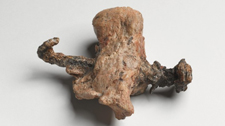
|
|
|
|
|
Artifact Analysis
|
|
|
|
- The Crucified Man
-

In 1968, Israeli archaeologist Vassilios Tzaferis discovered an ossuary in a family tomb north of Jerusalem that contained the bones of two men and a young child. One of the young men, in his twenties, still had the spike from his crucifixion piercing his ankle bone. The spike had been driven through a piece of wood to prevent him from tearing his leg off the small head of the spike during his ordeal, and the spike had bent when driven into the wood upright, making it impossible to remove the body from the cross without taking the spike and wood with it. To date, this is the only archaeological evidence of crucifixion from the ancient world, perhaps because part of this public, painful and protracted death involved the humiliation of having the body dumped in an open pit afterward, to be eaten by dogs. It is unusual that a family wealthy enough to have a rock-hewn tomb would have been able to secure the corpse for proper burial.-
- There have been two additional discoveries of remains that may derive from crucifixions. The first was discovered near Rovagio in northern Italy:
-
- Gualdi-Russo, Emanuela, Ursula Thun Hohenstein, Nicoletta Onisto, Elena Pilli and David Caramelli. "A Multidisciplinary Study of Calcaneal Trauma in Roman Italy: A Possible Case of Crucifixion?" Archaeological and Anthropological Sciences (2018). https://doi.org/10.1007/s12520-018-0631-9.
-
- An additional reference to evidence of crucifixion from the Nile region was made by:
-
- Aufderheide, Arthur C. and Conrado Rodriguez-Martin. "Crucifixion." In The Cambridge Encyclopedia of Human Paleopathology (Cambridge: Cambridge University Press, 1998) 38.
-
- These two references are not directly relevant for the Givat Ram skeleton, but may be interesting to read.
-
-
- Bibliography
-
- Cook, John Granger. Crucifixion in the Mediterranean World, WUNT 327. Tübingen: Mohr Siebeck, 2014.
-
- --------. "Envisioning Crucifixion: Light from Several Inscriptions and the Palatine Graffito." Novum testamentum 50:3 (2008) 262-85.
-
- Edwards, William D., Wesley J. Gabel and Floyd E. Hosmer. "On the Physical Death of Jesus Christ." Journal of the American Medical Association 255:11 (1986) 1455-1463.
-
- Haas, N. "Anthropological Observations on the Skeletal Remains from Giv'at ha-Mivtar." Israel Exploration Journal 20:1/2 (1970) 38-59.
-
- Naveh, J. "The Ossuary Inscriptions from Giv'at ha-Mivtar." Israel Exploration Journal 20:1/2 (1970) 33-7.
-
- Tzaferis, Vassilios. "Crucifixion: The Archaeological Evidence - Remains of a Jewish Victim of Crucifixion Found in Jerusalem." Biblical Archaeology Review 11:1 (1985) 44-53.
-
- --------. "Jewish Tombs at and near Giv'at ha-Mivtar, Jerusalem." Israel Exploration Journal 20:1/2 (1970) 18-32.
-
- Zias, Joseph. "Death and Disease in Ancient Israel." Biblical Archaeologist 54:3 (1991) 146-59.
-
- Zias, Joseph and Eliezer Sekeles. "The Crucified Man from Givʿat ha-Mivtar—A Reappraisal." Israel Exploration Journal 35 (1985) 22-7.
-
- Zugibe, Frederick T. "Death by Crucifixion." Canadian Society of Forensic Science Journal 17:1 (1984) 1-13.
-
- --------. "Two Questions about Crucifixion." Bible Review 2 (1989) 35-43.
-
-
|
|
|
|
|
